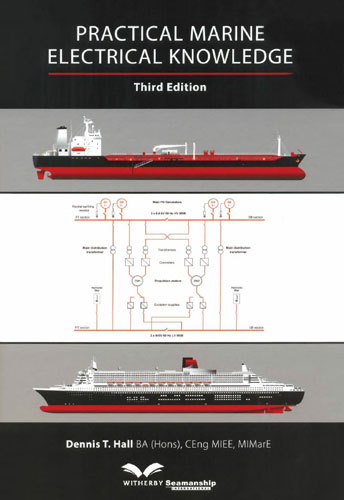Сб с 10 до 16
Practical marine electrical knowledge/Практические знания в области морской электротехники
Издание на английском языке
This book's objective is to help marine and electrical engineers acquire the knowledge required by STCW for management and operational level endorsements and to become more familiar with various electrical applications that can be found on board ship.
The systems are explained in terms of their operating principles and safe working practice. The type and significance of various electrical appliances, circuits and faults are considered and a common troubleshooting practice is examined.
A wide range of onboard ancillary electrical services are described, along with detailed information on battery support, care and maintenance. The application and operating principles of electrical propulsion are examined, as well as high voltage practice, safety procedures and testing methods.
This book will be helpful to management and operational level marine engineers, electrical engineers and electricians, as well as students currently studying marine and electrical engineering.
Contents
Preface
Chapter One Ships' Electrical Systems, Safety and Maintenance
1.1 Circuit Calculations
1.2 Electrical Diagrams
1.3 Electrical Safety
1.4 ElectricShock
1.5 Insulation Resistance
1.6 Circuit Testing
1.7 Insulation Testing
1.8 Continuity Testing
1.9 Multimeters
1.10 DiodeTests
1.11 Current Clampmeters
1.12 Live-Line Testers
1.13 General ElectricalMaintenance
1.14 Fault Finding
Chapter Two Electrical Distribution
2.1 Power Distribution System
2.2 Insulated and Earthed Neutral Systems
2.3 Significanceof Earth Faults
2.4 Distribution Circuit Breakers
2.5 Transformers
2.6 Instrument Transformers
2.7 Shore Supply Connection
2.8 Circuit Protection
2.9 Electric Cables
Chapter Three Generators and Main Circuit Breakers
3.1 AC Generator Operation
3.2 Generator Construction and Cooling
3.3 Excitation Methods
3.4 Automatic Voltage Regulation
3.5 Generators in Parallel
3.6 Emergency Generators
3.7 Generator Protection
3.8 Generator Maintenance
3.9 Main Switchboard
3.10 Main Circuit Breakers
Chapter Four Motors and Starters
4.1 Motor Construction
4.2 Enclosures and Ratings
4.3 Induction Motor Operation
4.4 Control Equipment
4.5 Directon Line (DOL) Starting
4.6 Reduced Voltage Starting
4.7 SpeedControl
4.8 Motor Protection
4.9 Single-Phase Motors
4.10 Maintenance
Chapter Five Ancillary Electrical Services
5.1 Navigation and Signal lights
5.2 Emergency lighting
5.3 Refrigeration and Air Conditioning
5.4 Cathodic Protection
5.5 Battery Supplies
Chapter Six Special Electrical Practice for Hazardous Atmospheres
6.1 Hazardous Zones on Tankers
6.2 Understanding the Fire Triangle
6.3 ExplosionGroupsand TemperatureClasses
6.4 Explosion Protection
6.5 Exd Flameproof Enclosure
6.6 Exi Intrinsic Safety
6.7 Exe Increased Safety
6.8 Exn Non-Sparking
6.9 Exp Pressurised Apparatus
6.10 Exm Encapsulation
6.11 Installing and Operating Electrical Systems in Hazardous Areas
6.12 Additional Class Rules for Tankers
6.13 Electrical Testing in Hazardous Areas
6.14 Maintenance of Exd-protected Apparatus
Chapter Seven Periodic Survey Requirements
7.1 SOLAS
7.2 Classification Societies
7.3 Main Electrical Survey Items
7.4 Generatorsand Governors
7.5 Circuit Breakers
7.6 Switchboards and Fittings
7.7 Cables
7.8 Insulation Resistance
7.9 Motorsand Starters
7.10 Emergency Power and Associated Equipment
7.11 Parts of Steering Gear
7.12 Navigation light Indicators
7.13 U MS Operation
7.14 Tankers
Chapter Eight Electric Propulsion and High Voltage
8.1 Electric Propulsion Scheme
8.2 Power Supply Network
8.3 Review of Motor Operation
8.4 Controlled Rectification and Inversion
8.5 Converter Types
8.6 Propulsion System Operation
8.7 Harmonics
8.8 Propulsion Auxiliaries and Protection
8.9 High Voltage on Ships
8.10 High Voltage Safety
8.11 High Voltage Equipment Testing
Appendix 1 COSWP Perm its to Work
Index




